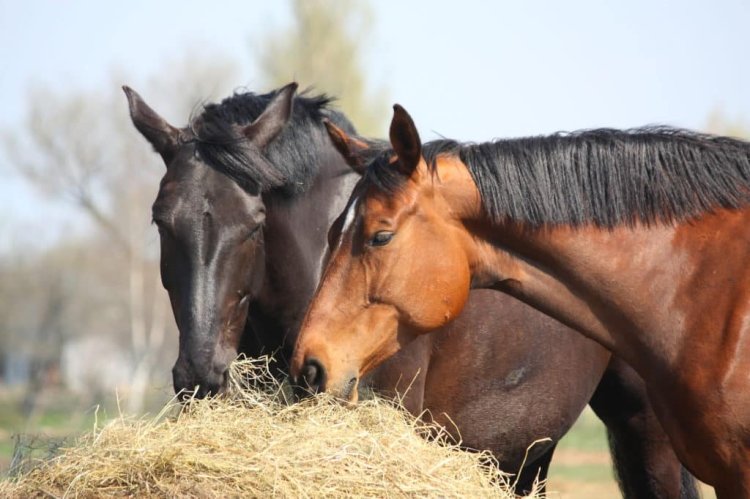in basket
TOP OFFER - SUMMER20 - 20% OFF and 4 FREE seasonal products!
Fibre in your horse's diet explained

Fibre explained
The term fibre is the collective term used to describe the cell wall components of the plant. There are two further definitions of fibre; physiological and chemical. The physiological definition describes fibre as the plant cell wall components that are resistant to digestion by the enzymes produced in the small intestine, whereas the chemical definition describes it as the sum of the structural carbohydrates plus lignin. Not all fibre is configured in the same way, in that the structural carbohydrates (CHO) in plant cell walls may be present in different forms and quantities.
Structural carbohydrates
The horse relies on the fermentation of fibre in the large intestine as a source of energy (from the volatile fatty acids produced) and also in maintaining gut health. Whereas in humans when we talk about energy and CHO, we are generally referring to starch (which is a non-structural CHO), although fat is also an energy source in humans and in horses. We often extrapolate information from other species due to there being a limited amount of work done in horses compared to other animals, including humans. However, whilst some comparisons are valid, others are not; for example, in humans we talk about bran as a laxative and have considered it to be the same in horses. However, since horses’ diets predominantly consist of fibre, and ours does not, the bran does not have a laxative effect on the horse in the same way that it does in humans.
As I have said in previous articles, it is important to understand CHO in horse diets. As a reminder the non-structural CHOs (such as starch, fructan and simple sugars) are digested by the enzymes in the horse’s foregut, whereas the structural CHOs are fermented by the microbes in the hindgut. These structural CHOs are found in the plant cell wall.
The plant cell wall
Plant cells are different to animal cells in that they have a cell wall (as discussed in previous articles), which is needed to provide rigidity and protection to the plant without preventing the diffusion of nutrients (including water) into the plant cell. As the plant grows the ratio of the cell wall to the cell contents increases, which means the cell wall increases in size and the cell contents decreases. This is because the stem of the plant develops to support the growing plant. For example, grass that has been grown for hay has a greater ratio of cell wall to cell contents compared to young leafy grass.
Plant cell walls serve as a major source of energy for horses. However, microbial degradation of cell wall components varies according to plant species, stage of development and different types of cell walls. The plant cell wall is predominantly composed of structural CHO and it is those CHOs that horses primarily derive their energy from. Structural CHOs are divided into three classes, cellulose, hemicellulose and pectin. As you may recall from my previous articles, the microbes in the horse’s hindgut degrade the fibre to produce volatile fatty acids, which are used as the main energy source by the horse.
Cellulose is the most abundant CHO found in the plant cell wall and the amount of this CHO increases as the plant grows. Hemicellulose is also a CHO that is present in the cell wall in close association with cellulose. Pectin is a CHO that is found in varying amounts in plants, depending on their species; for example, the pectin content of grass is low, whereas alfalfa can contain up to 30 percent pectin. Pectin is highly digestible in horses and is considered as an excellent source of fibre. Other fibrous feeds that are high in pectin include sugar beet pulp.
Lignin is a compound you may have heard of. It is important to point out that lignin is not a CHO, but it is closely associated with them. As the plant grows, the amount of structural CHOs present increases along with lignin. Lignin provides structural strength to the plant and is therefore present in higher amounts in the plant stem. Lignin is almost completely indigestible and because it entwines itself around the structural CHOs it can reduce the digestibility of them by preventing the microbes in the hindgut from accessing the cellulose, hemicellulose and pectin. This is why more mature forages, such as grass hay, which have a greater proportion of stem compared to younger pasture, are less digestible than immature grass in pastures.
Fibrous feedstuffs
Pasture herbage is the natural feed of horses and I have talked about the nutritional composition of pasture in previous articles. Seasonal growth in temperate climates necessitates the need to conserve forage for winter feeding. Furthermore, some horses may be stabled for part of the day year-round and therefore need to receive a conserved form of forage in the stable.
Hay in your horse's diet
Hay is plant material, grass in the UK, but can me made from other plant species such as alfalfa, which is common in the United States and Europe. Hay is the name for any plant material that has been dried to a low moisture content so that it is stable under ambient conditions. As a plant grows the amount of water it contains decreases, which is why grass is cut at a mature stage of growth when making hay as this makes drying in the field possible. The downside to that is that the hay contains a lot of stem with a high lignin content, which reduces its digestibility. However, as hay is a long chop forage it is beneficial for horses who, as I have talked about before, are intrinsically motivated to chew and also produce saliva during chewing; thus, long chop forage meets their behavior needs to chew and helps maintain a healthy gastric environment.
Alfalfa in your horse's diet
I’ve mentioned alfalfa before, and I wanted to talk a little more about it. In the UK alfalfa is grown in the south of England where the climate is better suited to its growth. However, instead if being made into hay it is typically cut at an earlier stage of growth and dried at high temperature in what look like large tumble driers. The result is a highly digestible fibre source, because there is less stemmy material and a feedstuff that is also stable at ambient temperatures. Alfalfa also contains considerable levels of pectin, which is highly digestible and as such high-temperature dried alfalfa is considered to be a quality source of fibre. The short chop, however, means that it is not recommended as the only forage source, because on a weight for weight basis horses will eat the short chop faster and may be left without forage before their next feed.
Sugar beet pulp in your horse's diet
Sugar beet pulp is one of the most undervalued and underutilised feedstuff for horses. Sugar beet pulp is the residue remaining after the extraction of sucrose from the root of the sugar beet plant. This residue is subsequently dried to facilitate transport and handling and is either shredded or cubed to produce dried sugar beet pulp. Sugar beet pulp is an excellent source of high quality, highly digestible fibre due to its high pectin content. Dried sugar beet pulp needs to be soaked before feeding as it will swell when ingested due to its high-water holding capacity. How long you soak it for depends on the manufacturer’s instructions, but some forms only need soaking for 10 minutes. Molasses is often added to sugar beet pulp, but the unmolassed type is best for horses as it reduces the amount of non-structural CHO your horse consumes, which is particularly important for horses that are overweight.
Bran in your horse's diet
I am going to talk a little more about bran as I briefly mentioned it above. Bran is the by-product of the cereal milling process, e.g. wheat bran or rice bran. It is high in fibre, but the fibre is largely indigestible as it contains high levels of lignin. As I said before, there is a myth that bran acts as a laxative in horses, but this is not the case. Even if a horse has slightly softer faeces after feeding a substantial amount of bran, this is most likely due to the sudden change in diet disrupting the microbial population in the hindgut. Bran does have a high-water holding capacity and is extremely palatable to horses; therefore, it can be useful as a way of encouraging a horse to eat and/or as a way of administering oral medications.
Summary recommendations around fibre in your horse's diet
Fibre is an essential part of every horse’s diet. All diets should be based on feeding fibre first and then adding on any additional feedstuffs, such as concentrate mixes containing starchy cereal grains. Fibre is a general term used to describe a type of feedstuff, but there are many different types of fibrous feeds with different compositions and digestibility. Some fibre feeds may be provided in a bucket feed; for example, if feeding alfalfa and sugar beet pulp. Alfalfa and sugar beet pulp are examples of good quality fibre sources that are highly digestible, have a high nutritious content, and help to maintain a healthy gut environment.
Article written for Premier Performance by Professor Jo-Anne Murray.






